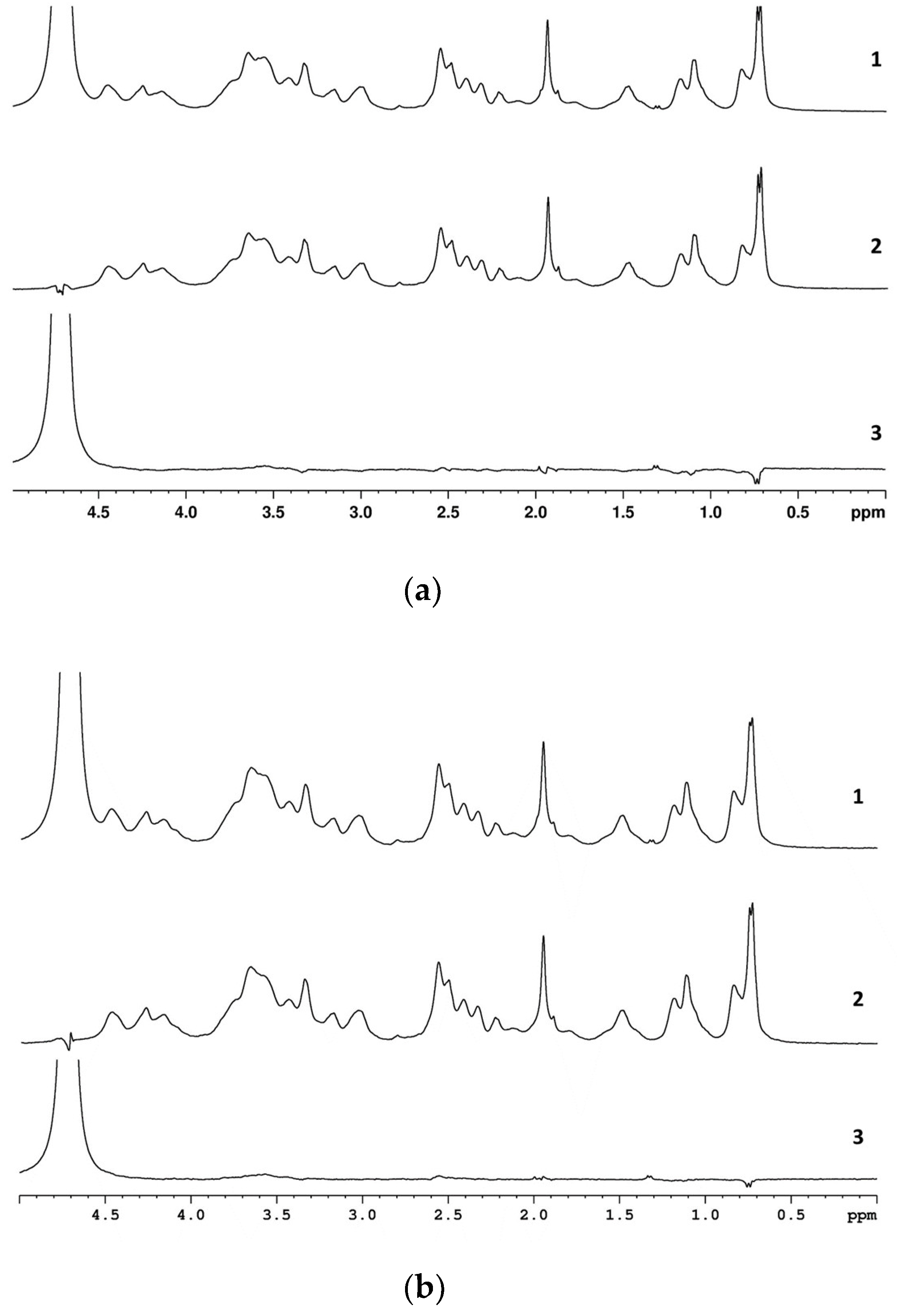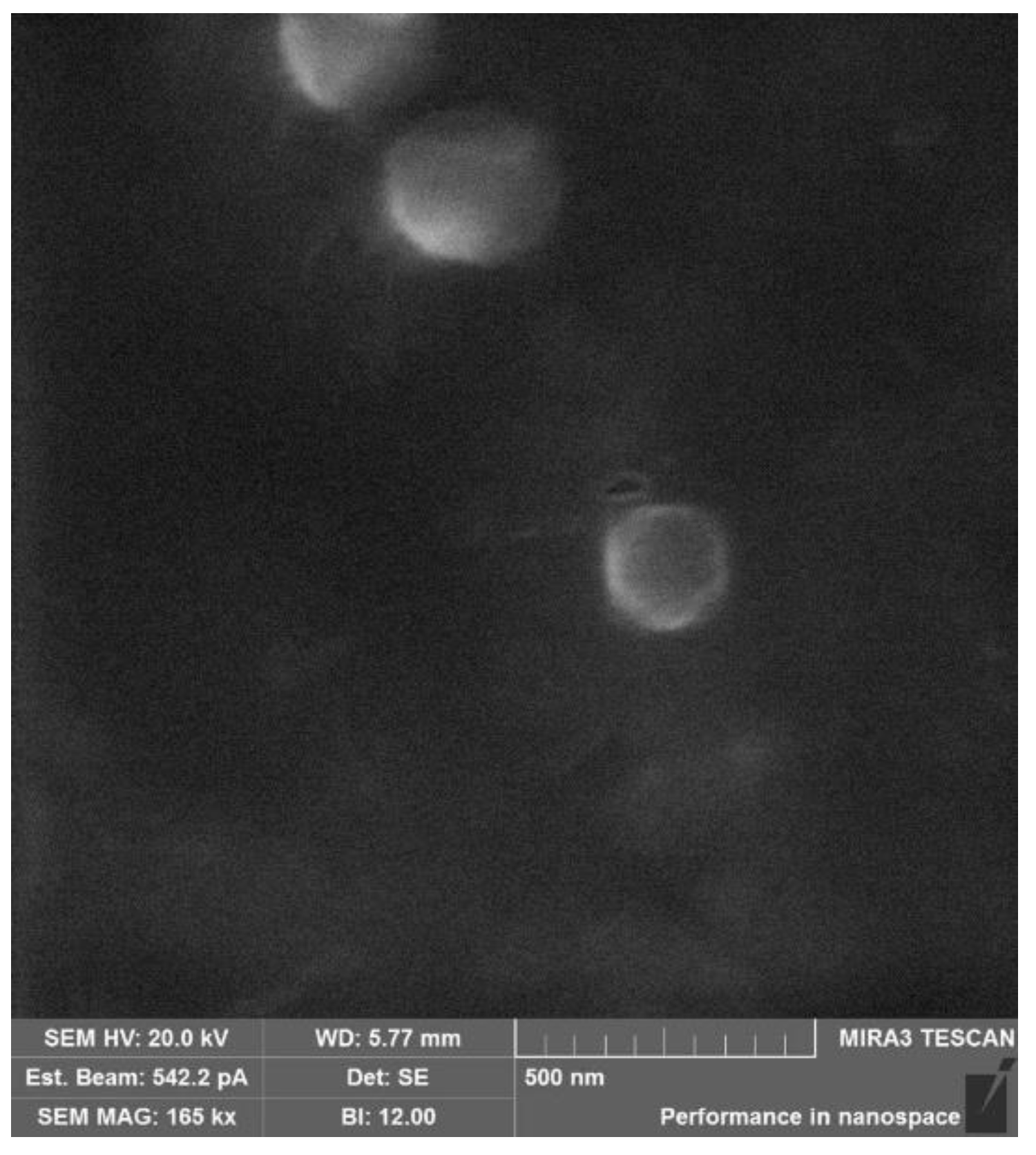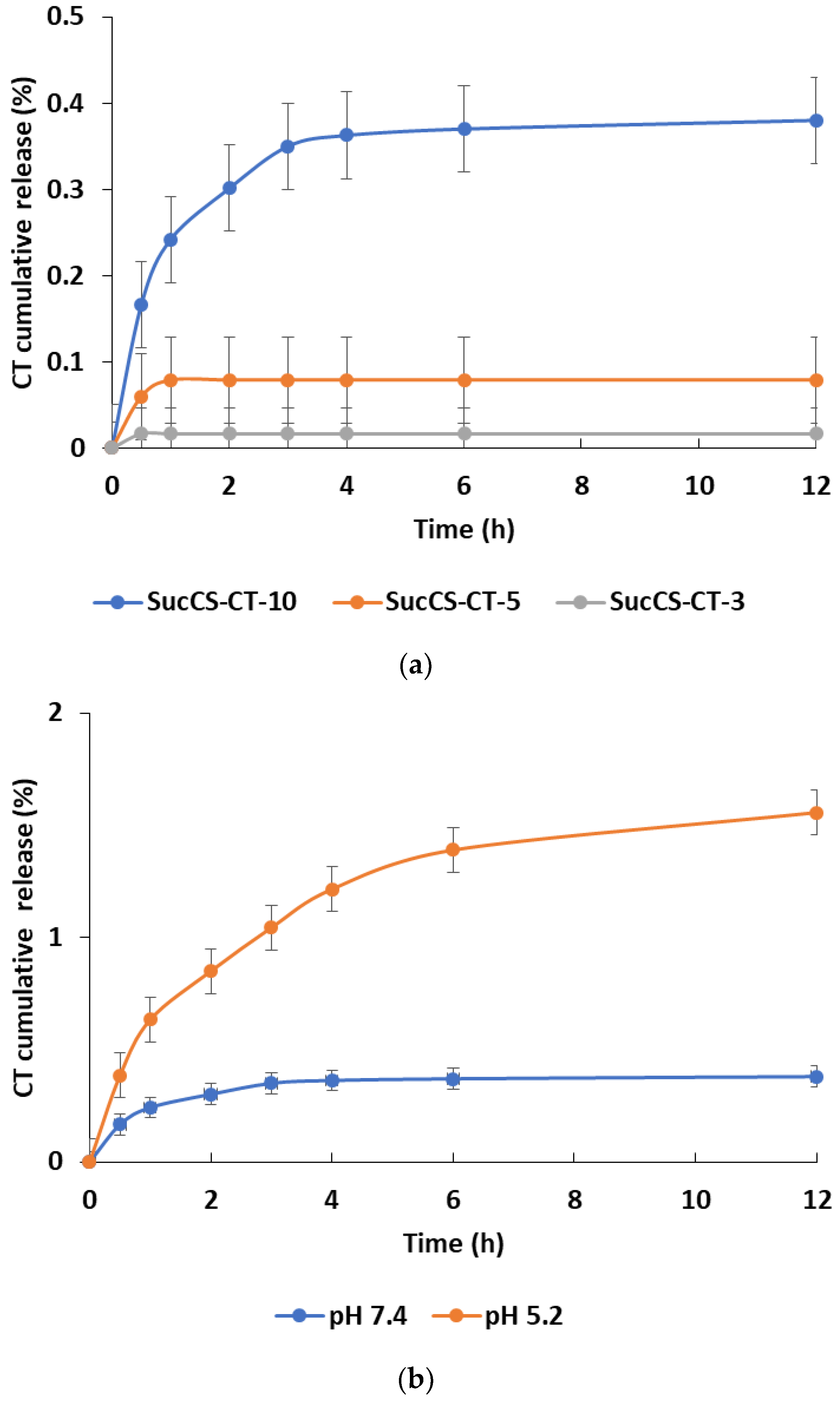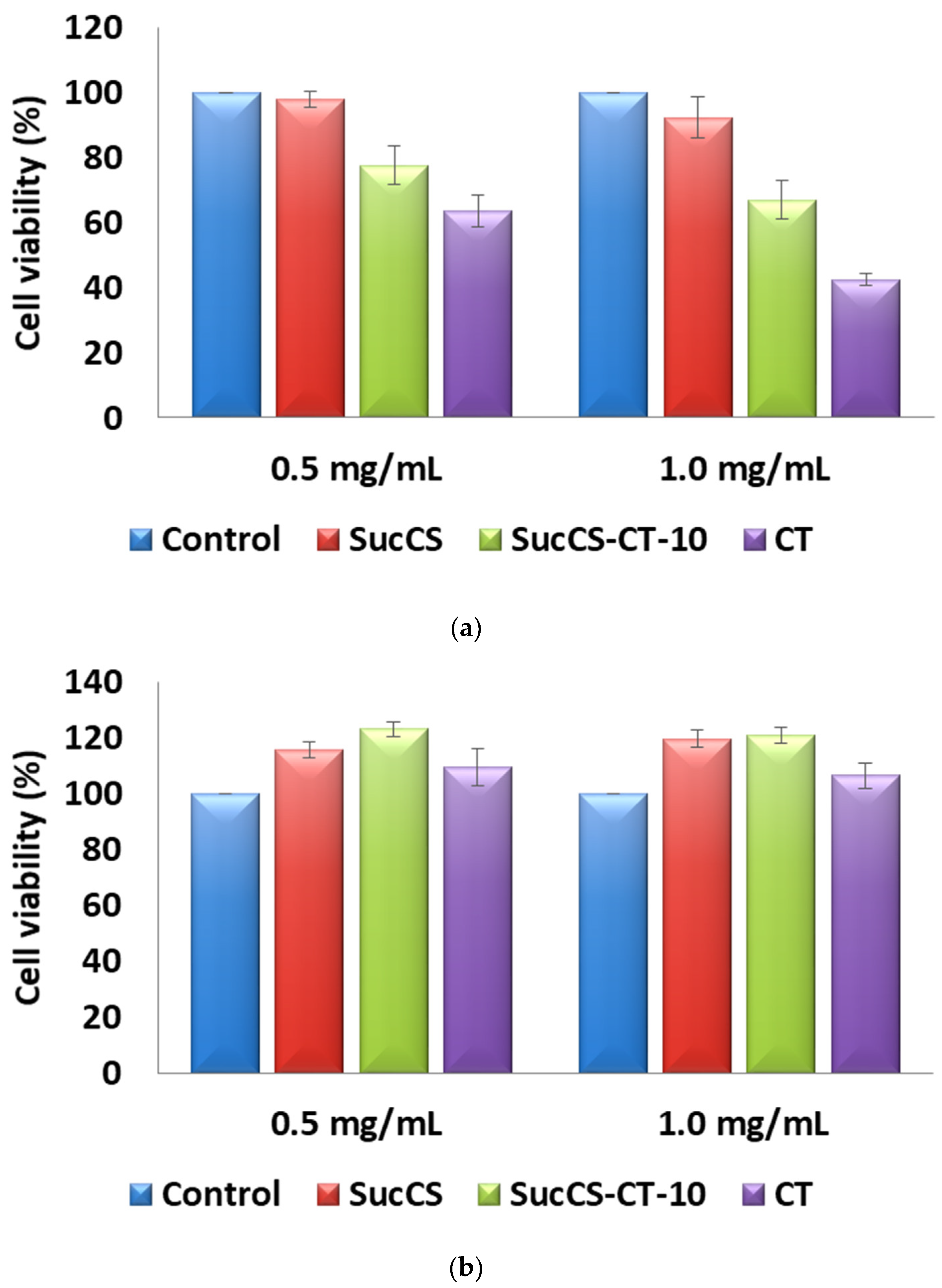Succinyl Chitosan-Colistin Conjugates as Promising Drug Delivery Systems
Abstract
1. Introduction
- (i)
- (ii)
- self-assembly of the resulting polymer systems into nanosize-structures for targeted antibiotic delivery in the infection inflammation site through the enhanced permeability and retention (EPR) effect [21], including intracellular targeting (as a result, the accumulation of higher doses at the site of infection at a lower total drug dose improves the biodistribution, maximizes the local bioavailability, and minimizes the systemic toxicity of the antimicrobial agent [16,22,23], as well as reduces the risk of side effects and the possibility of developing microbial resistance [2,24]);
- (iii)
- controlled release and prolonged drug residence time in circulation;
- (iv)
- the possibility of including both hydrophilic and hydrophobic components (expands the possibilities of pharmaceutical development of new antimicrobial formulations [25]);
- (v)
2. Results
2.1. Synthesis and Characterization of Succinyl Chitosan
2.2. Synthesis and Characterization of Succinyl Chitosan-Colistin Conjugates
2.3. Physicochemical Characterization of the Succinyl Chitosan-Colistin Conjugates
2.4. Colistinrelease Kinetics from the Succinyl Chitosan-Colistin Conjugates
2.5. Antimicrobial Activity of the Succinyl Chitosan-Colistin Conjugates
2.6. Cytotoxicity of the Succinyl Chitosan-Colistin Conjugates
2.7. Anti-Inflammatory Activity of the SucCS-CT Conjugates
3. Discussion
4. Materials and Methods
4.1. Materials and Reagents
4.2. Synthesis of the Succinyl Chitosan
4.3. Synthesis of the Succinyl Chitosan-Colistin Conjugates
4.4. NMR Characterization of the Succinyl Chitosan and Succinyl Chitosan-Colistin Conjugates
4.5. Determination of Colistin Content in the Succinyl Chitosan-Colistin Conjugates and Conjugation Efficiency
4.6. Physicochemical Characterization of the Succinyl Chitosan-Colistin Conjugates
4.7. In Vitro Colistin Release from the Succinyl Chitosan-Colistin Conjugates
4.8. Antimicrobial Activity of the Succinyl Chitosan-Colistin Conjugates
4.9. Cytotoxicity Study of the Succinyl Chitosan-Colistin Conjugates
4.10. Anti-Inflammatory Activity of the SucCS-CT Conjugates
5. Conclusions
- (i)
- A two-step synthetic procedure was developed for the carbodiimide conjugation of the peptide antibiotic CT with CS via a succinyl linker to form a slow hydrolyzable amide bond. For this purpose, the initial CS was succinylated previously to achieve a DS of 70%. Then, using different molar ratios of the reactants, SucCS-CT with different DS (ranging from 3 to 8%) was obtained; the CT content was 130–318 μg/mg. It was demonstrated that the CE decreased from 80–100% to 50% when the CT in the reaction mixture was increased from 3–10 to 15 mol%. Thus, increasing the amount of CT above 10 mol% relative to SucCS is not reasonable.
- (ii)
- The resulting systems formed associates in an aqueous solution (PBS, pH 7.4) with a ζ-potential of −22 to −28 mV and a hydrodynamic diameter of 100–200 nm that provided both good physical colloidal stability and aggregative resistance against blood components due to suitable surface charge as well as improved delivery through improved vascular distribution, tissue permeability, molecular binding, and intracellular transport due to physiological size.
- (iii)
- In vitro studies demonstrated that the developed conjugates practically did not release CT for 12 h under both physiological and inflammation site conditions (about 0.4–1.5% for 12 h). The body environment has its own characteristics related to the presence of enzymes that can affect the hydrolysis and release of the drug from the drug-polymer conjugates. However, succinylated CS is less biodegradable than the original CS; therefore, SucCS is an excellent polymer carrier for sustained-release delivery systems.
- (iv)
- At the same time, the antimicrobial activity of the obtained conjugates depended on the DS; the SucCS-CT with high DS (about 8%) exhibited comparable antimicrobial activity with native CT (1 μg/mL). In this case, the rate of conjugate hydrolysis is not a determinant of its pharmacological efficacy.
- (v)
- Nevertheless, conjugation of CT with SucCS reduced nephrotoxicity (HEK 293 cells) compared with native CT (20–60% lower) and neurotoxicity (T 98G cells). Since the decrease in cytotoxicity is related to the covalent grafting of CT to the polymer, slow hydrolysis, in this case, has an important positive effect.
- (vi)
- Finally, the obtained conjugates exhibited anti-inflammatory activity like native CT in an LPS-induced inflammation model in vitro; however, the conjugation of CT with SucCS reduced the cytotoxic activity of CT against THP-1 cells. Moreover, unlike native CT, SucCS-CT conjugates at low concentrations (10–1 μg/mL) exhibited low cytotoxic and high anti-inflammatory activity, which may be useful for developing a new anti-inflammatory agent.
Supplementary Materials
Author Contributions
Funding
Institutional Review Board Statement
Informed Consent Statement
Data Availability Statement
Conflicts of Interest
References
- Dostert, M.; Trimble, M.J.; Hancock, R.E. Antibiofilm peptides: Overcoming biofilm-related treatment failure. RSC Adv. 2021, 11, 2718–2728. [Google Scholar] [CrossRef] [PubMed]
- Brooks, B.D.; Brooks, A.E. Therapeutic strategies to combat antibiotic resistance. Adv. Drug Deliv. Rev. 2014, 78, 14–27. [Google Scholar] [CrossRef] [PubMed]
- World Health Organization. Antimicrobial Resistance Global Report on Surveillance: 2014 Summary; World Health Organization: Geneva, Switzerland, 2014. [Google Scholar]
- World Health Organization. Who Publishes List of Bacteria for Which New Antibiotics Are Urgently Needed; World Health Organization: Geneva, Switzerland, 2017. [Google Scholar]
- Mulani, M.S.; Kamble, E.E.; Kumkar, S.N.; Tawre, M.S.; Pardesi, K.R. Emerging strategies to combat eskape pathogens in the era of antimicrobial resistance: A review. Front. Microbiol. 2019, 10, 539. [Google Scholar] [CrossRef] [PubMed]
- Dubashynskaya, N.V.; Raik, S.V.; Dubrovskii, Y.A.; Demyanova, E.V.; Shcherbakova, E.S.; Poshina, D.N.; Shasherina, A.Y.; Anufrikov, Y.A.; Skorik, Y.A. Hyaluronan/diethylaminoethyl chitosan polyelectrolyte complexes as carriers for improved colistin delivery. Int. J. Mol. Sci. 2021, 22, 8381. [Google Scholar] [CrossRef]
- Dubashynskaya, N.V.; Raik, S.V.; Dubrovskii, Y.A.; Shcherbakova, E.S.; Demyanova, E.V.; Shasherina, A.Y.; Anufrikov, Y.A.; Poshina, D.N.; Dobrodumov, A.V.; Skorik, Y.A. Hyaluronan/colistin polyelectrolyte complexes: Promising antiinfective drug delivery systems. Int. J. Biol. Macromol. 2021, 187, 157–165. [Google Scholar] [CrossRef]
- Hancock, R. Antibacterial peptides and the outer membranes of gram-negative bacilli. J. Med. Microbiol. 1997, 46, 1–3. [Google Scholar]
- Khondker, A.; Rheinstädter, M.C. How do bacterial membranes resist polymyxin antibiotics? Commun. Biol. 2020, 3, 77. [Google Scholar] [CrossRef]
- Vardakas, K.Z.; Falagas, M.E. Colistin versus polymyxin b for the treatment of patients with multidrug-resistant gram-negative infections: A systematic review and meta-analysis. Int. J. Antimicrob. Agents 2017, 49, 233–238. [Google Scholar] [CrossRef]
- Khondker, A.; Dhaliwal, A.K.; Saem, S.; Mahmood, A.; Fradin, C.; Moran-Mirabal, J.; Rheinstädter, M.C. Membrane charge and lipid packing determine polymyxin-induced membrane damage. Commun. Biol. 2019, 2, 67. [Google Scholar] [CrossRef]
- Zhang, H.; Srinivas, S.; Xu, Y.; Wei, W.; Feng, Y. Genetic and biochemical mechanisms for bacterial lipid a modifiers associated with polymyxin resistance. Trends Biochem. Sci. 2019, 44, 973–988. [Google Scholar] [CrossRef]
- Pelgrift, R.Y.; Friedman, A.J. Nanotechnology as a therapeutic tool to combat microbial resistance. Adv. Drug Deliv. Rev. 2013, 65, 1803–1815. [Google Scholar] [CrossRef] [PubMed]
- Oliota, A.F.; Penteado, S.T.; Tonin, F.S.; Fernandez-Llimos, F.; Sanches, A.C. Nephrotoxicity prevalence in patients treated with polymyxins: A systematic review with meta-analysis of observational studies. Diagn. Microbiol. Infect. Dis. 2019, 94, 41–49. [Google Scholar] [CrossRef] [PubMed]
- Dai, C.; Xiao, X.; Li, J.; Ciccotosto, G.D.; Cappai, R.; Tang, S.; Schneider-Futschik, E.K.; Hoyer, D.; Velkov, T.; Shen, J. Molecular mechanisms of neurotoxicity induced by polymyxins and chemoprevention. ACS Chem. Neurosci. 2018, 10, 120–131. [Google Scholar] [CrossRef] [PubMed]
- Huh, A.J.; Kwon, Y.J. “Nanoantibiotics”: A new paradigm for treating infectious diseases using nanomaterials in the antibiotics resistant era. J. Control. Release 2011, 156, 128–145. [Google Scholar] [CrossRef] [PubMed]
- Lainson, J.C.; Fuenmayor, M.F.; Johnston, S.A.; Diehnelt, C.W. Conjugation approach to produce a staphylococcus aureus synbody with activity in serum. Bioconjug. Chem. 2015, 26, 2125–2132. [Google Scholar] [CrossRef] [PubMed]
- Dubashynskaya, N.V.; Bokatyi, A.N.; Gasilova, E.R.; Dobrodumov, A.V.; Dubrovskii, Y.A.; Knyazeva, E.S.; Nashchekina, Y.A.; Demyanova, E.V.; Skorik, Y.A. Hyaluronan-colistin conjugates: Synthesis, characterization, and prospects for medical applications. Int. J. Biol. Macromol. 2022, 215, 243–252. [Google Scholar] [CrossRef]
- Faya, M.; Kalhapure, R.S.; Kumalo, H.M.; Waddad, A.Y.; Omolo, C.; Govender, T. Conjugates and nano-delivery of antimicrobial peptides for enhancing therapeutic activity. J. Drug Deliv. Sci. Technol. 2018, 44, 153–171. [Google Scholar] [CrossRef]
- Sobczak, M.; Debek, C.; Oledzka, E.; Kozlowski, R. Polymeric systems of antimicrobial peptides-strategies and potential applications. Molecules 2013, 18, 14122–14137. [Google Scholar] [CrossRef]
- Azzopardi, E.A.; Ferguson, E.L.; Thomas, D.W. The enhanced permeability retention effect: A new paradigm for drug targeting in infection. J. Antimicrob. Chemother. 2013, 68, 257–274. [Google Scholar] [CrossRef]
- Sanchis, J.; Canal, F.; Lucas, R.; Vicent, M.J. Polymer–drug conjugates for novel molecular targets. Nanomedicine 2010, 5, 915–935. [Google Scholar] [CrossRef]
- Dornelles Cherobim, M.; Correa Amaral, A.; Campos Dias, S.; Luiz Franco, O. Nanoformulated antibiotics: The next step for pathogenic bacteria control. Curr. Med. Chem. 2013, 20, 1232–1240. [Google Scholar]
- Kovalainen, M.; Monkare, J.; Riikonen, J.; Pesonen, U.; Vlasova, M.; Salonen, J.; Lehto, V.P.; Jarvinen, K.; Herzig, K.H. Novel delivery systems for improving the clinical use of peptides. Pharmacol. Rev. 2015, 67, 541–561. [Google Scholar] [CrossRef] [PubMed]
- Gelperina, S.; Kisich, K.; Iseman, M.D.; Heifets, L. The potential advantages of nanoparticle drug delivery systems in chemotherapy of tuberculosis. Am. J. Respir. Crit. Care Med. 2005, 172, 1487–1490. [Google Scholar] [CrossRef] [PubMed]
- Patel, A.; Cholkar, K.; Mitra, A.K. Recent developments in protein and peptide parenteral delivery approaches. Ther. Deliv. 2014, 5, 337–365. [Google Scholar] [CrossRef] [PubMed]
- Castelletto, V.; Newby, G.; Zhu, Z.; Hamley, I.; Noirez, L. Self-assembly of pegylated peptide conjugates containing a modified amyloid β-peptide fragment. Langmuir 2010, 26, 9986–9996. [Google Scholar] [CrossRef]
- Nicolas, P. Multifunctional host defense peptides: Intracellular-targeting antimicrobial peptides. FEBS J. 2009, 276, 6483–6496. [Google Scholar] [CrossRef]
- Du, A.W.; Stenzel, M.H. Drug carriers for the delivery of therapeutic peptides. Biomacromolecules 2014, 15, 1097–1114. [Google Scholar] [CrossRef]
- Azzopardi, E.A.; Ferguson, E.L.; Thomas, D.W. Development and validation of an in vitro pharmacokinetic/pharmacodynamic model to test the antibacterial efficacy of antibiotic polymer conjugates. Antimicrob. Agents Chemother. 2015, 59, 1837–1843. [Google Scholar] [CrossRef]
- Peng, X.; Zhu, L.; Guo, J.; Sun, Z.; Zhao, M.; Zhan, X. Enhancing biocompatibility and neuronal anti-inflammatory activity of polymyxin b through conjugation with gellan gum. Int. J. Biol. Macromol. 2020, 147, 734–740. [Google Scholar] [CrossRef]
- Dua, K.; Bebawy, M.; Awasthi, R.; Tekade, R.K.; Tekade, M.; Gupta, G.; De Jesus Andreoli Pinto, T.; Hansbro, P.M. Application of chitosan and its derivatives in nanocarrier based pulmonary drug delivery systems. Pharm. Nanotechnol. 2017, 5, 243–249. [Google Scholar] [CrossRef]
- Garg, U.; Chauhan, S.; Nagaich, U.; Jain, N. Current advances in chitosan nanoparticles based drug delivery and targeting. Adv. Pharm. Bull. 2019, 9, 195. [Google Scholar] [CrossRef] [PubMed]
- Kato, Y.; Onishi, H.; Machida, Y. Biological characteristics of lactosaminated n-succinyl-chitosan as a liver-specific drug carrier in mice. J. Control. Release 2001, 70, 295–307. [Google Scholar] [CrossRef] [PubMed]
- Kato, Y.; Onishi, H.; Machida, Y. Evaluation of n-succinyl-chitosan as a systemic long-circulating polymer. Biomaterials 2000, 21, 1579–1585. [Google Scholar] [CrossRef] [PubMed]
- Dubashynskaya, N.V.; Bokatyi, A.N.; Golovkin, A.S.; Kudryavtsev, I.V.; Serebryakova, M.K.; Trulioff, A.S.; Dubrovskii, Y.A.; Skorik, Y.A. Synthesis and characterization of novel succinyl chitosan-dexamethasone conjugates for potential intravitreal dexamethasone delivery. Int. J. Mol. Sci. 2021, 22, 10960. [Google Scholar] [CrossRef]
- Lukacik, P.; Barnard, T.J.; Buchanan, S.K. Using a Bacteriocin Structure to Engineer a Phage Lysin That Targets Yersinia Pestis; Portland Press Ltd.: London, UK, 2012. [Google Scholar]
- Ferguson, E.L.; Azzopardi, E.; Roberts, J.L.; Walsh, T.R.; Thomas, D.W. Dextrin–colistin conjugates as a model bioresponsive treatment for multidrug resistant bacterial infections. Mol. Pharm. 2014, 11, 4437–4447. [Google Scholar] [CrossRef]
- Gupta, S.; Govil, D.; Kakar, P.N.; Prakash, O.; Arora, D.; Das, S.; Govil, P.; Malhotra, A. Colistin and polymyxin b: A re-emergence. Indian J. Crit. Care Med. 2009, 13, 49. [Google Scholar]
- Azzopardi, E.A.; Ferguson, E.L.; Thomas, D.W. Colistin past and future: A bibliographic analysis. J. Crit. Care 2013, 28, 219.e13–219.e19. [Google Scholar] [CrossRef]
- Dubashynskaya, N.V.; Skorik, Y.A. Polymyxin delivery systems: Recent advances and challenges. Pharmaceuticals 2020, 13, 83. [Google Scholar] [CrossRef]
- Skorik, Y.A.; Kritchenkov, A.S.; Moskalenko, Y.E.; Golyshev, A.A.; Raik, S.V.; Whaley, A.K.; Vasina, L.V.; Sonin, D.L. Synthesis of n-succinyl-and n-glutaryl-chitosan derivatives and their antioxidant, antiplatelet, and anticoagulant activity. Carbohydr. Polym. 2017, 166, 166–172. [Google Scholar] [CrossRef]
- Sadat, S.M.; Jahan, S.T.; Haddadi, A. Effects of size and surface charge of polymeric nanoparticles on in vitro and in vivo applications. J. Biomater. Nanobiotechnol. 2016, 7, 91. [Google Scholar] [CrossRef]
- Hickey, J.W.; Santos, J.L.; Williford, J.-M.; Mao, H.-Q. Control of polymeric nanoparticle size to improve therapeutic delivery. J. Control. Release 2015, 219, 536–547. [Google Scholar] [CrossRef] [PubMed]
- Gajdács, M. The concept of an ideal antibiotic: Implications for drug design. Molecules 2019, 24, 892. [Google Scholar] [CrossRef] [PubMed]
- Folliero, V.; Dell’Annunziata, F.; Roscetto, E.; Cammarota, M.; De Filippis, A.; Schiraldi, C.; Catania, M.R.; Casolaro, V.; Perrella, A.; Galdiero, M. Niclosamide as a repurposing drug against corynebacterium striatum multidrug-resistant infections. Antibiotics 2022, 11, 651. [Google Scholar] [CrossRef] [PubMed]
- Dell’Annunziata, F.; Folliero, V.; Palma, F.; Crudele, V.; Finamore, E.; Sanna, G.; Manzin, A.; De Filippis, A.; Galdiero, M.; Franci, G. Anthraquinone rhein exhibits antibacterial activity against staphylococcus aureus. Appl. Sci. 2022, 12, 8691. [Google Scholar] [CrossRef]
- Raik, S.V.; Poshina, D.N.; Lyalina, T.A.; Polyakov, D.S.; Vasilyev, V.B.; Kritchenkov, A.S.; Skorik, Y.A. N-[4-(n, n, n-trimethylammonium) benzyl] chitosan chloride: Synthesis, interaction with DNA and evaluation of transfection efficiency. Carbohydr. Polym. 2018, 181, 693–700. [Google Scholar] [CrossRef]
- Pogodina, N.; Pavlov, G.; Bushin, S.; Mel’Nikov, A.; Lysenko, Y.B.; Nud’Ga, L.; Marsheva, V.; Marchenko, G.; Tsvetkov, V. Conformational characteristics of chitosan molecules as demonstrated by diffusion-sedimentation analysis and viscometry. Polym. Sci. USSR 1986, 28, 251–259. [Google Scholar] [CrossRef]
- Iudin, D.; Zashikhina, N.; Demyanova, E.; Korzhikov-Vlakh, V.; Shcherbakova, E.; Boroznjak, R.; Tarasenko, I.; Zakharova, N.; Lavrentieva, A.; Skorik, Y.; et al. Polypeptide self-assembled nanoparticles as delivery systems for polymyxins b and e. Pharmaceutics 2020, 12, 868. [Google Scholar] [CrossRef]
- Filipe, V.; Hawe, A.; Jiskoot, W. Critical evaluation of nanoparticle tracking analysis (nta) by nanosight for the measurement of nanoparticles and protein aggregates. Pharm. Res. 2010, 27, 796–810. [Google Scholar] [CrossRef]
- Greatti, V.R.; Oda, F.; Sorrechia, R.; Kapp, B.R.; Seraphim, C.M.; Weckwerth, A.; Chorilli, M.; Da Silva, P.B.; Eloy, J.O.; Kogan, M.J.; et al. Poly-epsilon-caprolactone nanoparticles loaded with 4-nerolidylcatechol (4-nc) for growth inhibition of microsporum canis. Antibiotics 2020, 9, 894. [Google Scholar] [CrossRef]
- Dubashynskaya, N.V.; Golovkin, A.S.; Kudryavtsev, I.V.; Prikhodko, S.S.; Trulioff, A.S.; Bokatyi, A.N.; Poshina, D.N.; Raik, S.V.; Skorik, Y.A. Mucoadhesive cholesterol-chitosan self-assembled particles for topical ocular delivery of dexamethasone. Int. J. Biol. Macromol. 2020, 158, 811–818. [Google Scholar] [CrossRef]
- Mindukshev, I.V.; Kudryavtsev, I.V.; Serebriakova, M.K.; Trulioff, A.S.; Gambaryan, S.P.; Sudnitsyna, J.S.; Avdonin, P.V.; Jenkins, R.O.; Goncharov, N.V. Flow cytometry and light-scattering techniques in evaluation of nutraceuticals. In Nutraceuticals; Elsevier: Amsterdam, The Netherlands, 2021; pp. 379–393. [Google Scholar]







| Sample | Molar Ratio of the Reactants | DS (%) | CE (%) | CT-Content (μg/mg) | |||
|---|---|---|---|---|---|---|---|
| SucCS | CT | EDC | NHS | ||||
| SucCS-CT-3 | 1 | 0.03 | 2 | 2 | 3 | 100.0 ± 0.8 | 130 ± 1 |
| SucCS-CT-5 | 1 | 0.05 | 2 | 2 | 5 | 99.8 ± 1.1 | 187 ± 2 |
| SucCS-CT-10 | 1 | 0.10 | 2 | 2 | 8 | 81.0 ± 1.6 | 311 ± 5 |
| SucCS-CT-15 | 1 | 0.15 | 2 | 2 | 8 | 54.4 ± 1.5 | 318 ± 5 |
| Sample | Hydrodynamic Diameter ± SD (nm) | ζ-Potential ± SD (mV) | |
|---|---|---|---|
| by DSL | by NTA | ||
| SucCS-CT-3 | 114 ± 17 | 113 ± 58 | −27.7 ± 0.5 |
| SucCS-CT-5 | 149 ± 16 | 137 ± 40 | −26.0 ± 0.9 |
| SucCS-CT-10 | 180 ± 21 | 202 ± 67 | −22.4 ± 0.6 |
| No Stimulation 94.5 ± 0.2 | |||
|---|---|---|---|
| Concentration | SucCS | CT | SucCS-CT-10 |
| 1000 µg/mL | 94.3 ± 0.4 | 69 ± 2 *** | 85 ± 3 *** |
| 500 µg/mL | 94.7 ± 0.4 | 84.9 ± 0.6 *** | 93.7 ± 1.0 |
| 100 µg/mL | 93.7 ± 0.4 | 93.3 ± 0.5 | 92.9 ± 0.6 |
| 10 µg/mL | 94.9 ± 0.4 | 94.7 ± 0.5 | 94.4 ± 0.5 |
| 1 µg/mL | 94.8 ± 0.5 | 94.2 ± 0.5 | 95.07 ± 0.18 |
| No Stimulation 0.685 ± 0.017 | |||
|---|---|---|---|
| Concentration | SucCS | CT | SucCS-CT-10 |
| 1000 µg/mL | 8.7 ± 1.4 *** | 1.61 ± 0.08 *** | 10.3 ± 1.8 *** |
| 500 µg/mL | 2.1 ± 0.2 *** | 0.960 ± 0.061 *** | 3.0 ± 0.4 *** |
| 100 µg/mL | 0.82 ± 0.06 | 0.720 ± 0.015 | 0.93 ± 0.06 *** |
| 10 µg/mL | 0.663 ± 0.016 | 0.674 ± 0.015 | 0.72 ± 0.03 |
| 1 µg/mL | 0.664 ± 0.016 | 0.653 ± 0.017 | 0.69 ± 0.04 |
| LPS-Treated Cells 8.7 ± 1.3 | |||
|---|---|---|---|
| Concentration | SucCS | CT | SucCS-CT-10 |
| 1000 µg/mL | 11 ± 2 | 2.11 ± 0.18 | 9.8 ± 1.9 |
| 500 µg/mL | 4.6 ± 0.5 | 1.5 ± 0.3 ** | 2.3 ± 0.3 ** |
| 100 µg/mL | 5.1 ± 0.6 | 0.85 ± 0.04 *** | 1.03 ± 0.06 *** |
| 10 µg/mL | 8.8 ± 1.2 | 0.89 ± 0.07 *** | 1.14 ± 0.16 *** |
| 1 µg/mL | 7.9 ± 1.1 | 0.99 ± 0.14 *** | 1.47 ± 0.18 *** |
Disclaimer/Publisher’s Note: The statements, opinions and data contained in all publications are solely those of the individual author(s) and contributor(s) and not of MDPI and/or the editor(s). MDPI and/or the editor(s) disclaim responsibility for any injury to people or property resulting from any ideas, methods, instructions or products referred to in the content. |
© 2022 by the authors. Licensee MDPI, Basel, Switzerland. This article is an open access article distributed under the terms and conditions of the Creative Commons Attribution (CC BY) license (https://creativecommons.org/licenses/by/4.0/).
Share and Cite
Dubashynskaya, N.V.; Bokatyi, A.N.; Dobrodumov, A.V.; Kudryavtsev, I.V.; Trulioff, A.S.; Rubinstein, A.A.; Aquino, A.D.; Dubrovskii, Y.A.; Knyazeva, E.S.; Demyanova, E.V.; et al. Succinyl Chitosan-Colistin Conjugates as Promising Drug Delivery Systems. Int. J. Mol. Sci. 2023, 24, 166. https://doi.org/10.3390/ijms24010166
Dubashynskaya NV, Bokatyi AN, Dobrodumov AV, Kudryavtsev IV, Trulioff AS, Rubinstein AA, Aquino AD, Dubrovskii YA, Knyazeva ES, Demyanova EV, et al. Succinyl Chitosan-Colistin Conjugates as Promising Drug Delivery Systems. International Journal of Molecular Sciences. 2023; 24(1):166. https://doi.org/10.3390/ijms24010166
Chicago/Turabian StyleDubashynskaya, Natallia V., Anton N. Bokatyi, Anatoliy V. Dobrodumov, Igor V. Kudryavtsev, Andrey S. Trulioff, Artem A. Rubinstein, Arthur D. Aquino, Yaroslav A. Dubrovskii, Elena S. Knyazeva, Elena V. Demyanova, and et al. 2023. "Succinyl Chitosan-Colistin Conjugates as Promising Drug Delivery Systems" International Journal of Molecular Sciences 24, no. 1: 166. https://doi.org/10.3390/ijms24010166
APA StyleDubashynskaya, N. V., Bokatyi, A. N., Dobrodumov, A. V., Kudryavtsev, I. V., Trulioff, A. S., Rubinstein, A. A., Aquino, A. D., Dubrovskii, Y. A., Knyazeva, E. S., Demyanova, E. V., Nashchekina, Y. A., & Skorik, Y. A. (2023). Succinyl Chitosan-Colistin Conjugates as Promising Drug Delivery Systems. International Journal of Molecular Sciences, 24(1), 166. https://doi.org/10.3390/ijms24010166









